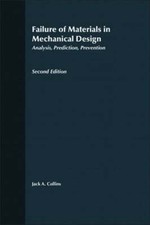Picture 1 of 4

Stock photo




Picture 1 of 4

Stock photo




Failure of Materials in Mechanical Design : Analysis, Prediction, Prevention by Jack A. Collins (1993, Hardcover)

Liquidstuff (2609)
99.2% positive feedback
Price:
$75.00
+ $5.97 shipping
Returns:
Condition:
Oops! Looks like we're having trouble connecting to our server.
Refresh your browser window to try again.
About this product
Product Identifiers
PublisherWiley & Sons, Incorporated, John
ISBN-100471558915
ISBN-139780471558910
eBay Product ID (ePID)662549
Product Key Features
Number of Pages672 Pages
LanguageEnglish
Publication NameFailure of Materials in Mechanical Design : Analysis, Prediction, Prevention
SubjectMaterials Science / General, Mechanics / Statics, Fracture Mechanics, Mechanical
Publication Year1993
FeaturesRevised
TypeTextbook
AuthorJack A. Collins
Subject AreaTechnology & Engineering, Science
FormatHardcover
Dimensions
Item Height1.4 in
Item Weight34.5 Oz
Item Length9.6 in
Item Width6.4 in
Additional Product Features
Edition Number2
Intended AudienceScholarly & Professional
LCCN92-035907
Dewey Edition20
IllustratedYes
Dewey Decimal620.112
Table Of ContentThe Role of Failure Prevention Analysis in Mechanical Design. Modes of Mechanical Failure. Strength and Deformation of Engineering Metals. State of Stress. Relationships Between Stress and Strain. Combined Stress Theories of Failure and Their Use in Design. High-Cycle Fatigue. Concepts of Cumulative Damage, Life Prediction, and FractureControl. Use of Statistics in Fatigue Analysis. Fatigue Testing Procedures and Statistical Interpretations ofData. Low-Cycle Fatigue. Stress Concentration. Creep, Stress Rupture, and Fatigue. Fretting, Fretting Fatigue, and Fretting Wear. Shock and Impact. Buckling and Instability. Wear, Corrosion, and Other Important Failure Modes. Index.
Edition DescriptionRevised edition
SynopsisThe discovery and application of abstract musical properties has had a prominent role in compositional and theoretical literature during the past 40 years, and an accumulation of source material has been produced that makes a single cross-referenced source essential for standard working procedures. Abstract musical properties, most often associated with analytical or compositional systems, are presented here in an unbiased context that allows the reader freedom of association and interpretation. This type of reference is an important tool for anyone who uses set-class analysis in coursework, or independent thesis research. This book is intended to help verify musical intuition and has an immediate practical application for composers and theorists curious about intervallic properties and transformational potentials of any pitch-class set. It can provide supplemental material for coursework involving theory, analysis, and stylistic awareness of compositional or analytical styles, and also for learning and confirming economical presentations characteristic of recent music-theoretical literature. Organized in two parts, the first is a profile of all set-classes in charts allowing quick comparisons among them, including set-class reference tables, set-classes arranged by ascending interval-class vectors, and a summary of transformational invariances. The second part focuses on individual set-classes, listing its contents, subsets, and significant references to the collection in musical or theoretical literature. Internal segmentations of each set-class that are more structurally informative and memorizable than prime-forms are offered. Three appendices, an extensive bibliography, an index of selected analytical viewpoint and styles, and an index of terms are also included., Failure of Materials in Mechanical Design: Analysis, Prediction, Prevention, 2nd Edition, covers the basic principles of failure of metallic and non-metallic materials in mechanical design applications. Updated to include new developments on fracture mechanics, including both linear-elastic and elastic-plastic mechanics. Contains new material on strain and crack development and behavior. Emphasizes the potential for mechanical failure brought about by the stresses, strains and energy transfers in machine parts that result from the forces, deflections and energy inputs applied., Covers the basic principles of failure of metallic and non-metallic materials in mechanical design applications. Updated to include new developments on fracture mechanics, including both linear-elastic and elastic-plastic mechanics. Contains new material on strain and crack development and behavior.
LC Classification NumberTA460.C63 1993
All listings for this product
Ratings and Reviews
Most relevant reviews
- Apr 10, 2020
Very thorough resource on failure modes for metals
This is a great book. I wanted to learn more about different failure modes in materials, and this book is very thorough. I'm only a couple chapters in, but it seems to cover mostly metals, so I'll likely need to get some more resources for other material types. I'm still learning a lot from it though.Verified purchase: YesCondition: Pre-owned


































